Twenty-First Century High-Performance Limestone Plaster
Historic exterior finish material meets modern environmental performance criteria
![]() Continuing Education
Continuing Education
Use the following learning objectives to focus your study while reading this month’s Continuing Education article.
Learning Objectives - After reading this article, you will be able to:
- Define high-performance limestone plaster cladding and compare its historic use in Europe to modern performance criteria.
- Describe the environmental and durability benefits of using this material for strength, moisture control, defenses against mold, mildew, breathability (perm rating), and air permeance.
- Evaluate the use of this exterior cladding as part of a project attaining a green building rating that requires materials to be in compliance with the USGBC’s REACH legislation documentation and those that have published Health Product Declaration Open Compliance Standards.
- Explain why this material requires no control joints when applied to a mass wall, providing a new alternative for designers choosing smooth, monolithic exterior finishes.
- Discuss the advantages of using an integrally colored stone material that requires no painting or recoloring and can be matched for additions or renovations.
The aesthetics and performance of an exterior material are prime elements that every design professional investigates when selecting an exterior finish. For those who are seeking environmental benefits, materials must meet high-performance attributes, particularly in the areas of energy savings, moisture control, and material components that are not harmful to the environment. It may be surprising that architects are discovering that a new material with environmental performance values that exceed codes is also an ancient material. High-performance limestone plaster, or HPLP, is a new term for an ancient material composed of natural hydraulic lime, hydrated lime, and elongated sand. Through research, third-party testing, and quality controls, HPLP exterior cladding is available using the same materials as historic high-performance lime plasters.
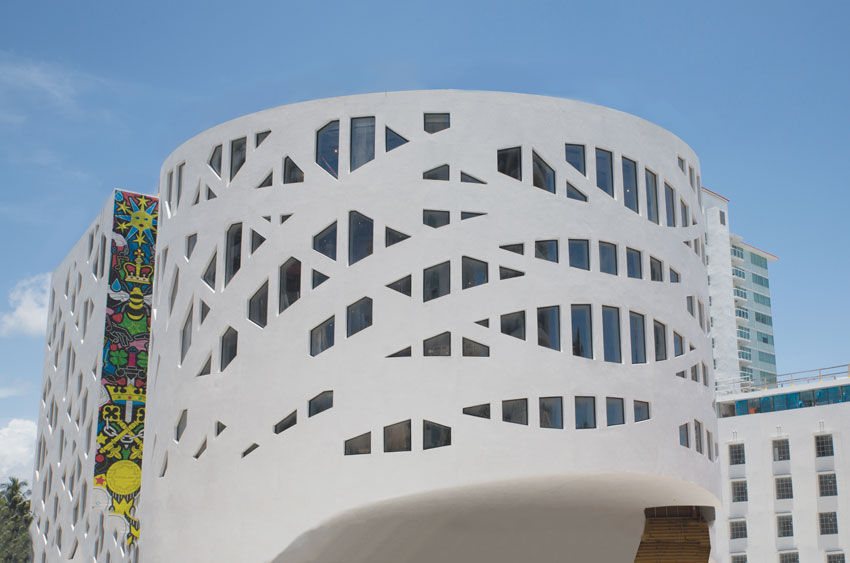
Photo courtesy of Thermocromex
The architect achieved a smooth, monolithic exterior at this art center in Miami by selecting a high-performance limestone plaster cladding.
Architects are using this product to achieve the highest of environmental building ratings in contemporary architecture and as a material that radiates light and permanence, while providing energy savings, moisture control, breathability, and strength.
Raw Materials Matter: Unique St. Astier Lime
To get the quality needed to meet the durability, breathability, and flexibility required for use at the renovation of the Michigan State Capital, preservation architect Eugene C. Hopkins, FAIA, principal at HopkinsBurns Design Studio, chose a hydraulic lime plaster from St. Astier in France. He recommended the use of lime plaster because it is an authentic and proven material, saying, “We tested the original plaster and mixed the same ratios of sand and lime using a three-coat application. We also installed horsehair in the brown coat. The previous system lasted for 100 years so why mess it up?” Preservationists choose lime from St. Astier because of its unique geologic location. The purity of hydraulic lime from St. Astier guarantees a product that provides high-performance environmental benefits. The Louvre, Westminster Castle, and Notre Dame are just some of many famous buildings that were constructed using St. Astier lime.
The lime deposits at St. Astier are located between the French cities of Montaceix and Neuvic sur l’Isle (approximately 6.2 miles). This geological layer is more than 328 feet thick. It was formed during the Upper Cretaceous period (approximately 75 million years ago) by marine sediment (mostly crustacean and corals). The sea in the basin was not subject to severe currents, and this allowed the formation of a uniform and undisturbed layer of calcareous rock infiltrated mainly by silica, with insignificant traces of other elements. This characteristic of the rock is unique in Europe and is the reason why the lime used for historic preservation is so reliable. It has the highest concentration of lime without any impurities. Archeological evidence shows that since the time of the Romans, this lime was used in buildings. In 1833, Louis Vicat, a French engineer and authority in hydraulic limes, began industrial production of the lime at St. Astier for use all over the world.1
Fast forward to the 21st century and to architects who want to choose this high-performance historic material without the labor-intensive applications with horsehair brushes, multiple coats, and long drying times. HPLP is manufactured with strict product control of the materials that include lime and sand components. It can be applied in one coat, sprayed onto a variety of substrates in a one-coat finish with quick drying times. The basic components of high-performance limestone plaster include:
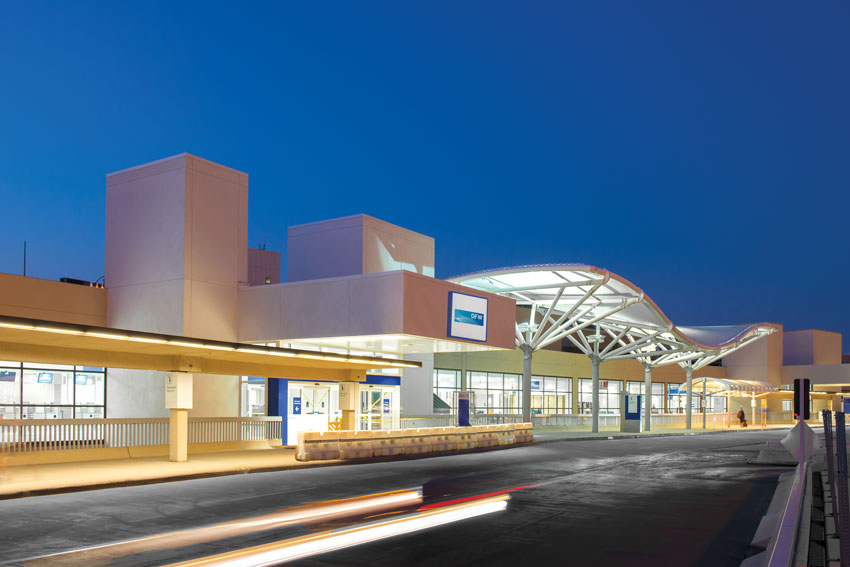
Photo courtesy of Thermocromex
Limestone plaster was directly applied to new CMU and existing precast concrete along with frame/sheathing wall assemblies to achieve uniformity in texture and color at the Dallas Fort Worth International Airport (DFW).
Hydrated Lime
Limestone is a calcareous rock that is extracted from the St. Astier quarry and crushed to create quicklime. During a highly controlled production process, water is added to create hydrated lime. A calcareous rock is a term used to identify a sediment, sedimentary rock, or soil type that is formed from, or contains a high proportion of, calcium carbonate in the form of calcite or aragonite.
The properties of lime make it a strong contender as a “miracle” building product. These include: “cohesion, adhesion, air content, water content, crystal shape, board life, spreadability, and flowability; bond strength; comprehensive strength; setting time; sand-carrying capacity; hydrolocity; free lime content; vapor permeability; flexibility; and resistance to sulfates. These qualities are affected by many factors during each step of manufacturing and installation. These include the original ingredients of the source of lime; added ingredients before and during firing, including inclusion of compounds from the fuel exhaust; firing temperature and duration; method of slaking, including a hot mix (quicklime added to sand and water to make mortar), dry slaking, and wet slaking; ratio of the mixture with aggregates and water; the sizes and types of aggregate; contaminants in the mixing water; workmanship; and rate of drying during curing.”2
Natural Hydraulic Lime
Hydraulic lime is the product of burning and slaking limestone. Natural hydraulic lime, or NHL, refers to the hydraulic properties of the selected lime product as a raw material with no additions, such as cement. The 21st century production process for HPLP is essentially the same as the one used since ancient times. The scientific knowledge of the manufacturer and modern quality control have, however, the favorable effect of producing reliable materials with constant performance. The method and the energy used in the burning process are the determining factors in the quantity of silica that combines with calcium oxide (CaO) to form calcium silicates (CS). This produces the environmental and durable performance of the finished products. Burning takes place in vertical kilns at temperatures not above 1,832 degrees Fahrenheit (1,000 degrees Celsius). The most efficient fuel with the least residuals is a high-quality anthracite coal imported from Wales and used at St. Astier. Continuous checks are made to measure the efficiency of the burning (CO2 tests), which are essential to regulate the hydration that follows. Hydration or slaking is a controlled hydration process. This process is so precise that virtually no quick lime (less than 1 percent) or impurities will be present at the end.
The European Union EU norms (EN/BS 459.1/2/3) on hydraulic lime state that natural hydraulic lime is the product of burning and slaking limestone. High-performance lime mixes should not contain any additions, such as pozzolans, gypsum, air entrainers, ash, or cement. The American standard, ASTM C-141: Standard Specification for Hydrated Hydraulic Lime (HHL) for Structural Purposes, provides guidance as to the required compressive strength of lime.
The compressive strength and hardness of natural hydraulic lime should meet numerous test standards listed in the chart at the end of this article. Natural hydraulic limes are workable, flexible, compatible with other components, and strong.3
Elongated Silica Sand
Elongated, not round sand, is mixed with the natural hydraulic lime to create a finished product with approximately 30 percent voids (versus 5 percent in cement-based finishes). Elongated sand is the key to making this product breathable with high permeability ratings.
Integral Color and Whiteness Factors
Limestone plasters can be selected with nonfading pigments. These mixes provide a controlled, integral color, which can be guaranteed to be consistent over all bags ordered. The color mixes are automated to record every batch so that future additions or renovations can be specified to match the original product. They are composed of eco-friendly, inorganic pigments integrated into the product that do not require a finishing color coating.
St. Astier is a quarry and a manufacturer that has operated more than 150 years. There are many different types of lime products. Design professionals can order lime mixes that can be used for sea walls and those with lower grades or untested grades of hardness. The purity of the components is important to assure strength and safeguard against efflorescence in the wall surface. Knowing the difference in lime mixes allows the design professional to specify a high-performance mix that achieves the environmental benefits of HPLP.
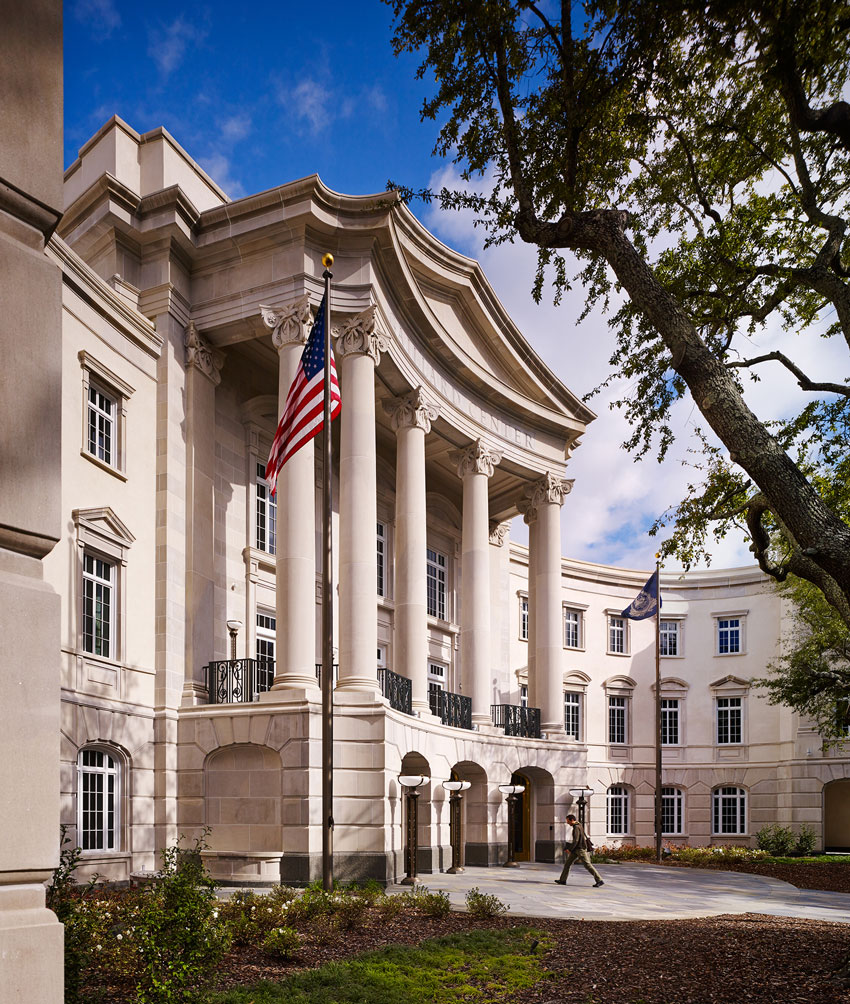
Photo courtesy of Steve Hall, Hedrich Blessing
The Galliard Center complements the historic district in Charleston, South Carolina, and by using high-performance limestone plaster, it also provides 21st century environmental advantages.
Performance Matters
The Galliard Center completed in 2015 by David M. Schwarz Architects and Earl Swensson Associates was originally planned as a small-scale renovation. This 1960s-era municipal auditorium and exhibit hall needed rehabilitation. The project quickly grew to include an additional 90,000 square feet for city offices and a complete overhaul of the entire building. The exterior cladding needed to be compatible with more than three different substrates. Located near the heart of the Charleston, South Carolina, historic district, the designers wanted to select a material that complemented adjacent buildings.
Many of the historic buildings in Charleston were clad in stucco, which since its introduction to America during the Civil War, has been comprised of a mix of lime with Portland cement. According to Steve Knight, associate at David M. Schwarz Architects, “A limestone-based plaster versus Portland cement-based stucco was chosen for the Galliard Center.” Choosing high-performance limestone plaster improved performance. “Limestone is softer than Portland cement, it allows for more movement without cracking…and, no need for control joints,” Knight adds. For this project, more than 200,000 square feet of high-performance limestone plaster was installed. The product was sprayed onto the wall and then hand-troweled to achieve smooth finishes. In some locations at the first-story base of the building, the material was applied to a greater thickness and recessed reveals were incorporated to simulate a rusticated base. When applied over a mass wall, there is no need for control joints, and it can be directly applied to brick, precast stone, unpainted stucco, concrete, concrete masonry units (CMU), and poured-in-place concrete (PIP).
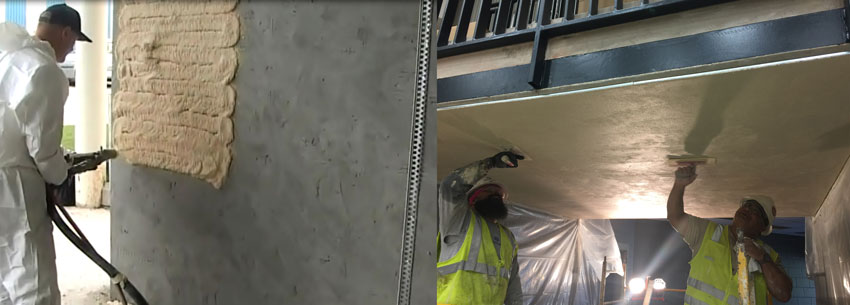
Photos courtesy of Thermocromex
Pictured is HPLP sprayed onto a wall (left) and troweled for a smooth finish (right). The HPLP was sprayed onto the wall in a single coat and then hand-troweled to achieve smooth finishes with block coursing to more than 200,000 square feet at the Galliard Center for Performing Arts.
HPLP is stone, and as such, the material reflects the light and provides the texture of a natural material. Knight says, “The ability of this finish to be directly applied to CMU and PIP concrete, keep out the rain, and provide a cladding that breathes was an exceptional bonus.” Limestone-based plaster is both new and old at the same time. It is a material that has been used in Europe for hundreds of years, while the spray-on application of 21st century products is both modern and efficient. “This high-performance finish addresses movement, vapor, and moisture barrier issues, as well,” he adds. “It provides a clean, smooth, and uninterrupted monolithic look.”
Performance matters when selecting finishes for new construction or renovations. In the case of high-performance limestone plaster, there are numerous distinctions to be made before specifying a product that exceeds building codes and green building criteria.
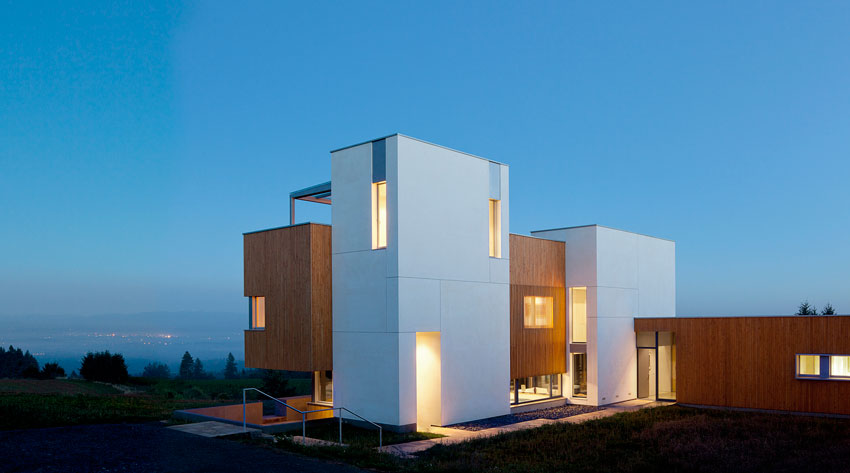
Photo courtesy of Jeremy Bittermann
The Karuna house is sited on an exposed hillside overlooking the Willamette Valley. Holst Architecture chose HPLP as the material for the anchoring towers because of performance values that contributed to environmental certifications. These included Passive House PHIUS+, LEED for Homes Platinum, and MINERGIE-P-ECO.
Meeting High-Performance Environmental Standards
According to Cory Hawbecker, senior associate at Holst Architecture in Portland, Oregon, the selection of HPLP for the Karuna House was a response to the client’s strict environmental requirements. “Karuna House is an ambitious sustainable design project that was designed to meet a combination of the world’s most demanding green building certifications,” he says. “The project is the first MINERGIE-certified building in North America, earning the top rating of MINERGIE-P-ECO. Additionally, it has achieved Passive House PHIUS+, LEED for Homes Platinum, and net-zero energy by incorporating on-site solar panels. It is expected to be one of the few homes in the world certified by both MINERGIE and Passive House Institute US, and is the first to earn all three certifications.” Hawbecker explained that MINERGIE is a Swiss green building rating system that is difficult to achieve. In this rating system, there are high-performance, production, and content requirements for materials used on a project. The owner, a leading proponent of smart climate policy and sound land use, “pursued the project as an environmental case study,” Hawbecker explains. “He directed the architects to select the most sustainable materials possible and particularly wanted to limit the use of cement to limit greenhouse gas emissions. Using a high-performance lime plaster not only limited greenhouse gas emissions, but the facade absorbs CO2 from the surrounding air.”
The house is located on an exposed southern slope of a mountain overlooking the Willamette Valley’s rich wine region. Karuna House provides spectacular views of majestic Mt. Hood and the Cascade Range to the east. Two towers, clad in HPLP, anchor Karuna House to the earth, marking the location of double-height spaces and vertical circulation. Hawbecker says, “Although the building is exposed to a tough climate from wind, rain, and snow, the finishes still look great.”
The home’s super-insulated envelope is designed to be airtight. Solar heat gain is controlled through the use of exterior operable blinds that shade triple-glazed windows. Heating, cooling, and hot water are supplied by an efficient heat pump system, and a heat recovery ventilator provides the spaces with a continuous supply of fresh, preheated air. The home’s tight building enclosure is expected to result in the usage of 90 percent less heating and cooling energy than a typical home.
Completed in 2013, this project has been awarded numerous awards reflecting its sustainable initiatives. These include the following:
- 2015 National Institute of Building Science Beyond Green Merit Award, High-Performance Buildings
- 2014 GreenBuilder Home of the Year Award, Best Building Science
- 2013 Portland 2030 Challenge Design Award for Excellence in Residential Net-Zero Energy
- 2013 Honoree; Portland Business Journal’s Innovation in Sustainability Awards, Energy
The performance benefits of high-performance lime plaster that contribute to the goals of an architect achieving sustainability initiatives include environmental performance for energy savings, materials and resources, and indoor air quality.
Optimizing Energy Performance: R-Values/Air Barriers/Air Permeance
Designing for energy efficiency requires conscientious detailing of exterior walls. All green rating systems require performance targets and modeling. To optimize energy performance, architects select exterior materials that can contribute to insulation values and create airtight enclosures that control moisture and vapor penetrations. The thermal resistance value, or R-value, of HPLP is 1.02 per inch of thickness, providing a greater resistance to heat loss than granite, marble, or even actual limestone.4 The insulation value of stucco is an R-value of .02 and of concrete, an R-value of .08.5 When directly applied to a mass wall with insulation on the interior side of a wall assembly as per the American Society of Heating, Refrigerating and Air-Conditioning Engineers (ASHRAE) and the International Energy Conservation Code (IECC), HPLP can become an integral part of a continuous insulation system.
However, it is the performance values for moisture control that make this product one of the best choices for environmental savings. According to Joseph Lstiburek at the Building Science Corporation, air barriers resist air pressure differences in buildings, keeping outside or inside air out of the building enclosure. “Airflow carries moisture that impacts a materials long-term performance (serviceability) and structural integrity (durability),” he explains. “Airflow also affects building behavior in a fire (spread of smoke and other toxic gases, supply of oxygen), indoor air quality (distribution of pollutants and location of microbial reservoirs), and thermal energy use. One of the key strategies in the control of airflow is the use of air barriers.”6
HPLP is a spray-on continuous exterior cladding that is impermeable to air flow. This material is strong, flexible, and durable, withstanding damage over the life of the building. Compliance to the ASHRAE 90.1-2010 and the 2012 IECC requirements for air leakage rates requires that material components or assemblies must meet a maximum air leakage rate of 0.04 cfm/ft2.7 HPLP applied at a 3/8-inch thickness as part of a wall assembly has been tested and confirmed to receive an air permeance value of 0.0024 cfm/ft2, far exceeding the recommended code values. As a result, energy costs are greatly reduced due to the natural capacity of HPLP for zero air infiltration.
HPLP exceeds air permeance values, while also providing a material that “breathes.” Vapor permeability is a standard measure of the water vapor permeability of a material. The higher the number, the more readily water vapor (in the gaseous state) can diffuse through the material. A perm rating of less than 0.1 is considered a Class I impermeable vapor retarder (which is also considered a vapor barrier); a perm rating between 0.1 and 1 is considered a Class II semi-permeable vapor retarder; a perm rating between 1 and 10 is a Class III permeable vapor retarder; and a perm rating greater than 10 is highly permeable and not considered to be a vapor retarder. HPLP provides a perm rating of 84, and allows moisture trapped in the building envelope to breath and dry out, eliminating most mold and mildew problems. In comparison, stucco is an absorptive cladding. Problems with the use of moisture barriers has caused numerous failures of stucco and EIFS walls due to improper installation and understanding of moisture control with an absorptive surface.8 A material that does not have high perm ratings requires careful detailing and the use of building papers, air, vapor, or water resistant barriers. HPLP naturally weatherproofs a building without the use of any moisture barriers, even when applied directly over CMU.
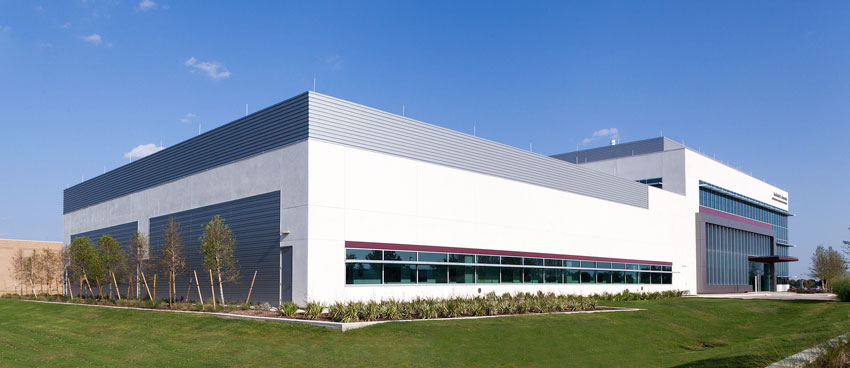
Photo courtesy of Thermocromex
The architects for the Texas A&M University Engineering Research Building in College Station, Texas, chose a high-performance limestone plaster for the aesthetics and performance attributes that included a monolithic skin.
Designed by Architect David Andrews/PGAL of Houston, Texas, the Texas A&M University Frederick E. Giesecke Engineering Research Building is located in Research Park in College Station, Texas. This integrative research facility for engineering focuses on three areas: nanofabrication, materials characterization, and energy research. The facility includes nanofabrication laboratories, the Corrosion Science and Materials Reliability Laboratory, and research space for faculty, staff, and students working for the Texas A&M Energy Institute. The high bay end of the building houses a series of mobile clean rooms, while the three-story portion is for the research laboratories and collaborative office space.
The building design was a collaborative effort between the design architect, Steve Ryder; the architect of record, David Andrews/PGAL of Houston, Texas; and one of the development partners, architect Don Nevins. Originally, the developer, DDM Group, proposed metal panels as the exterior finish for this three-story, 69,562-square-foot building. After a cost analysis, the architect and contractor began to review alternatives. They visited a 15-year-old building in town that was clad in HPLP and were “sold” on the durability and aesthetic of this material.
According to Giang Phan, LEED AP, senior associate at PGAL, “Limestone plaster high-performance cladding was chosen because it allowed for a smooth, consistent, and seamless finish—a design aesthetic our team wanted to achieve. With multiple integral color and texture options, the use of limestone plaster allowed for a wide range of design selections applied over large, uninterrupted walls with minimal use of control joints. The product was easily applied, gave the design team flexibility, and resulted in substantial cost savings.” The building was designed with different wall sections. The loading dock and adjacent storage areas are constructed of concrete masonry units and are a mass wall system. The rest of the building is framed. When installed over mass walls and direct applied substrates, HPLP does not require control joints, as it does not crack or shrink in response to thermal expansion.
Materials and Resources: Environmental Product Declarations, Low-Emitting Materials, and Global Warming
The intent of the U.S. Green Building Council LEED v4 credits for Materials and Resources is “to encourage the use of products and materials for which life-cycle information is available and that have environmentally, economically, and socially preferable life-cycle impacts.” HPLP that has been verified to as extracted or sourced in a responsible manner will provide credits in this category. Life-cycle information is available for HPLP products verified through compliance with USGBC’s REACH legislation documentation, as well as through the published Health Product Declaration Open Compliance Standard.
REACH is a regulation of the European Union, adopted to enhance the competitiveness of the EU chemicals industry. It also promotes alternative methods for the hazard assessment of substances in order to reduce the number of tests on animals. HPLP has no chemicals that are found as “substances of very high concern” on the REACH list. Manufacturers of this product have also published the complete content inventory following the Chemical Abstract Service Registration Number (CASRN), which is another option that can be used to verify life-cycle and material content for LEED v4 Materials and Resources.
HPLP is made of natural hydraulic lime (NHL) that is an inherently non-emitting source of volatile organic compounds (VOCs). HPLP does not contain chemical additives and has no impurities. This stone product does not permit the growth of mold or mildew that would contribute to poor air quality.
The production of HPLP uses 75 percent less energy than cement in its manufacturing process, thereby significantly reducing the amount of CO2, emissions released into the atmosphere. As an additional bonus, properties of natural hydraulic lime also absorb CO2, helping to mitigate global warming.
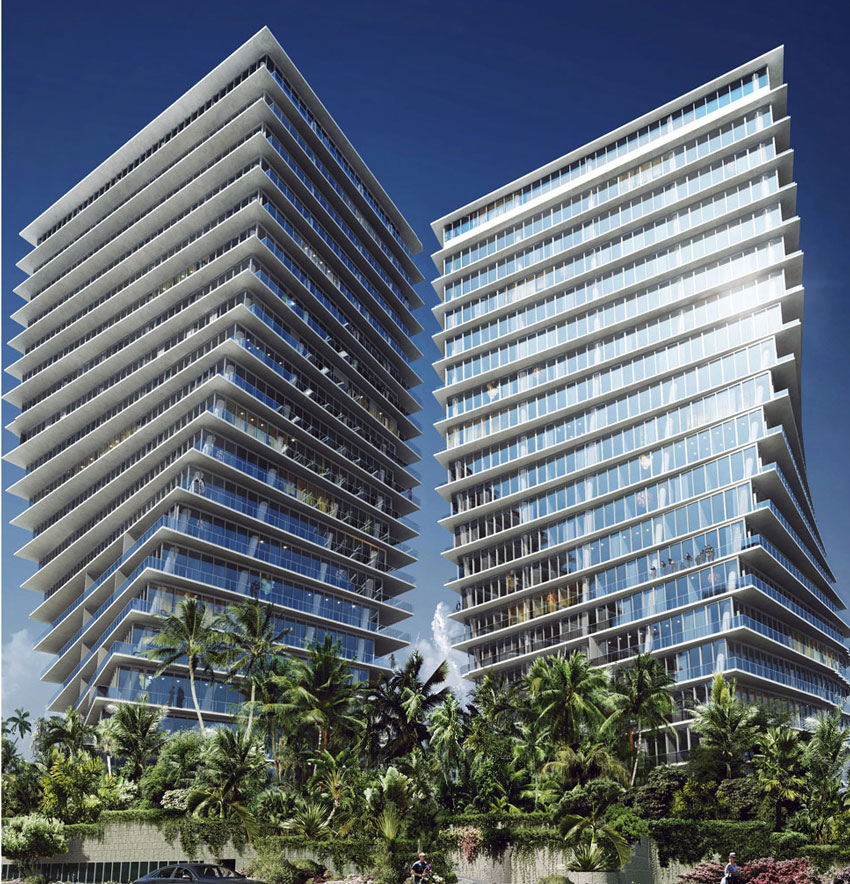
Photo courtesy of Thermocromex
The towers at the Grove at Grand Bay are the first LEED Silver-certified buildings in Coconut Grove, Florida.
Twenty-story-high towers at the Grove at Grand Bay, designed by the Bjarke Ingels Group in collaboration with Nichols Broch and Associates, are the first LEED Silver-certified buildings in Coconut Grove, Florida. Perched on the beach and with panoramic views of the Miami skyline as well as the ocean, the buildings’ impressive twisted forms are clad with HPLP. Exposed to wind and air laden with high salt content, the architect selected a material that meets strict wind design loads, while remaining blemish-free from efflorescence.
Florida (Miami-Dade County in particular) sets the standards for wind design loads for building products. Products must be tested to withstand large and small missile impacts, as this area is in the heart of hurricane exposure. HPLP have high wind load ratings and exceeds ASTM D6904: Standard Practice for Resistance to Wind-Driven Rain for Exterior Coatings Applied on Masonry.
Efflorescence is the migration of salt to a porous material that causes a white stain on the face of masonry buildings. The source of water-soluble salts varies, from salt-laden air to the components in cement and mortar mixes. A material like natural hydraulic lime does not contain impurities that would be susceptible to efflorescence, nor is it a porous material that would transport and deposit salt blemishes on the surface. HPLP is unaffected by efflorescence even in the Florida marine/salt air environment.
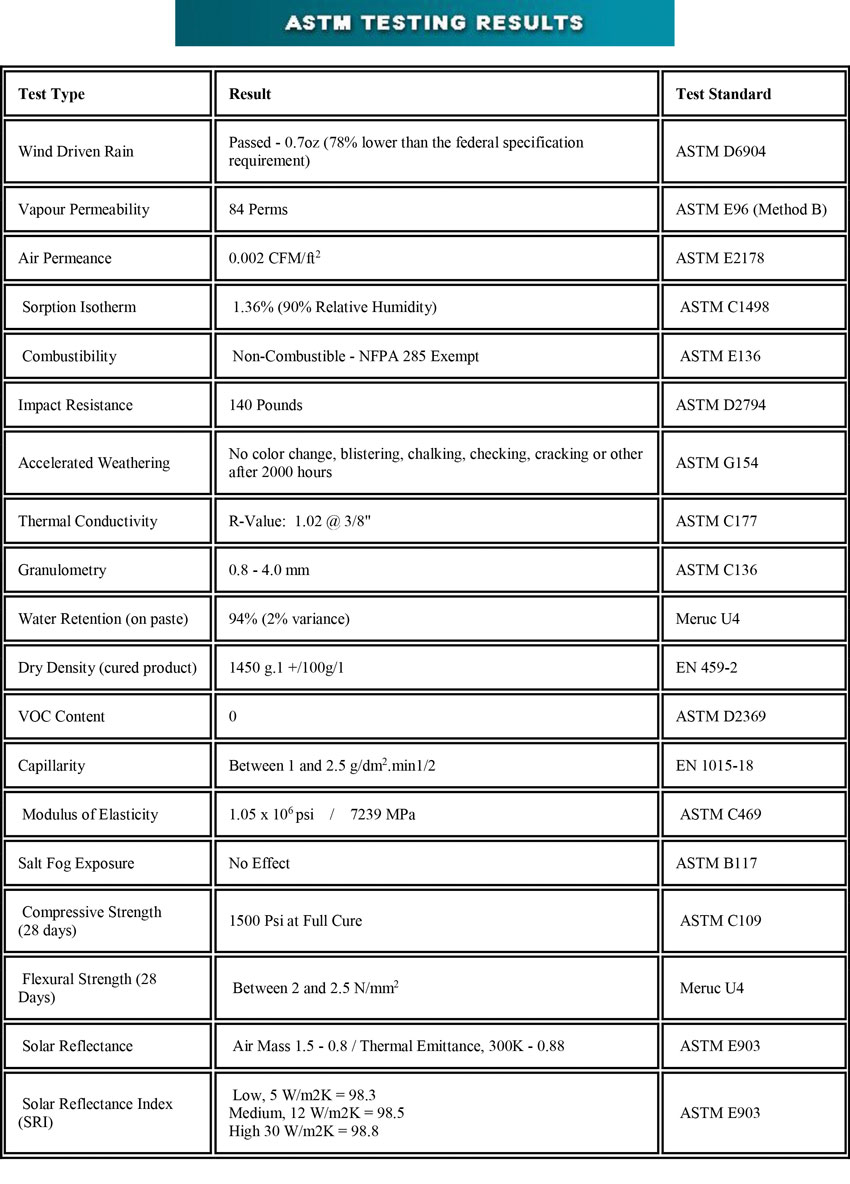
Image courtesy of Thermocromex
Example of technical performance data for one high-performance limestone plaster.
Simplified Installation
HPLP is applied in one coat and one pass to a prepared surface, unless more passes are required for special details or finishes. The material is pre-colored and will not need painting or sealing after installation. Installers trowel the surface to provide smooth or textured surfaces and may score the surface material to create the appearance of stone blocks. This product can duplicate the look of natural stone blocks, precast stone/concrete, and be selected in multiple colors. Most textures can be readily patched, and the use of non-fading pigments allow for future color matching.
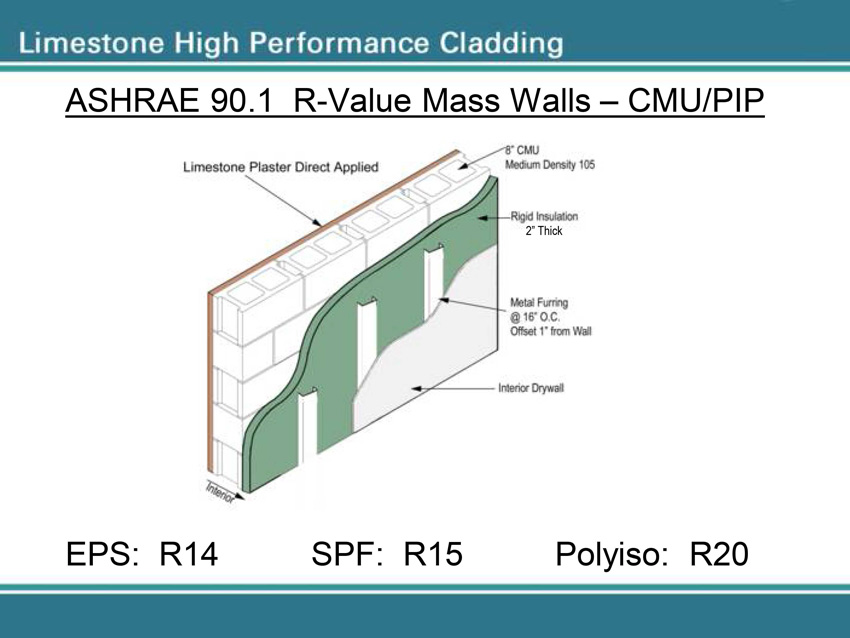
Image courtesy of Thermocromex
High-performance limestone cladding applied to mass wall.
HPLP can be directly applied onto a mass wall of concrete, block, or masonry. HPLP can also be applied over frame sheathing. Manufacturers can provide wall section details for a variety of surfaces. Sample details are also included in this article. Unlike stucco or other more absorptive materials, HPLP does not react to substrate materials, old or new wall systems, and can be used for renovating older buildings.
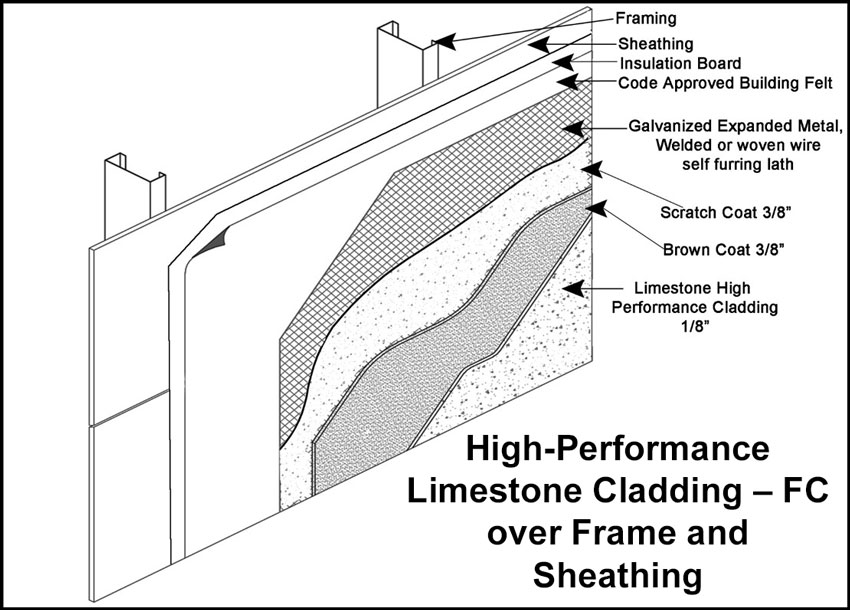
Image courtesy of Thermocromex
High-performance limestone cladding applied over frame and sheathing.
Back to the Future: Sustainable Historic Lime
There is no question that HPLP is a durable finish material, used in Europe for centuries, and tested and manufactured for use today. Seamlessly applied as a plaster on almost any wall surface and in any climate, HPLP is strong, durable, and sustainable. This material has been used in projects that include airports, hotels, shopping centers, education, and governmental buildings. HPLP is used on the majority of historical renovations, including The Louvre and Notre Dame. As demonstrated in the Karuna House and the Grove at Grand Bay, using HPLP as a surface material can contribute to the design and construction of buildings that meet the highest levels of environmental sustainability.
End Notes
1 “St. Astier Natural Hydraulic Limes.” Thermocromex. Web. 20 June 2016. http://thermocromex.com/history/.
2 Calcereous. Wikipedia. Web. 29 June 2016. https://en.wikipedia.org/wiki/Calcareous.
3 “Chemistry and mineralogy of the raw material.” Thermocromex. Web. 7 July 2016. http://thermocromex.com/test-and-research/.
4 “R-Value for Natural Stone.” MIA + BSI. Web. 22 June 2016. http://www.marble-institute.com/stoneprofessionals/technical-bulletins/rvalue/.
5 “Exterior Wall Insulation.” Energy Conservation in Construction and Design. The Louisiana Department of Natural Resources. Web. 22 June 2016. http://dnr.louisiana.gov/assets/TAD/education/ECEP/constr/b/b.htm.
6 Lstiburek, Joseph. “BSD104: Understanding Air Barriers.” Building Science Corporation. 24 Oct. 2006. Web. 22 June 2016. http://buildingscience.com/documents/digests/bsd-104-understanding-air-barriers.
7 “Meeting the Commercial Continuous Air Barrier Requirements for ASHRAE 90.1-2010 and the 2012 ICC IECC – Code Notes.” Building Energy Codes Resources Center. Web. 22 June 2016. https://www.energycodes.gov/sites/default/files/documents/cn_meeting_the_commercial_continuous_air_barrier_requirements
_for_ashrae_90.1-2010_and_the_2012_iec_iecc.pdf.
8 Lstiburek, Joseph. “BSI-029 Stucco Woes—The Perfect Storm.” Building Science Corporation. 22 Jan. 2010. Web. 22 June 2016. http://buildingscience.com/documents/insights/bsi-029-stucco-woes-the-perfect-storm.
Celeste Allen Novak, FAIA, LEED AP BD+C, is an architect, writer, and planning consultant in Michigan with a special focus on sustainable and universal design and rainwater collection systems. www.celesteallennovakarchitect.com

|
Thermocromex, the leading High Performance Limestone Plaster, is applied seamlessly achieving almost any texture, including smooth finishes. Extensive custom colors are available and comes pre-mixed for ease of installation. LEEDv4 potential 45 points in 8 categories. Its comprehensive 20-year performance warranty includes keeping out the rain, delamination, etc. www.thermocromex.com |
